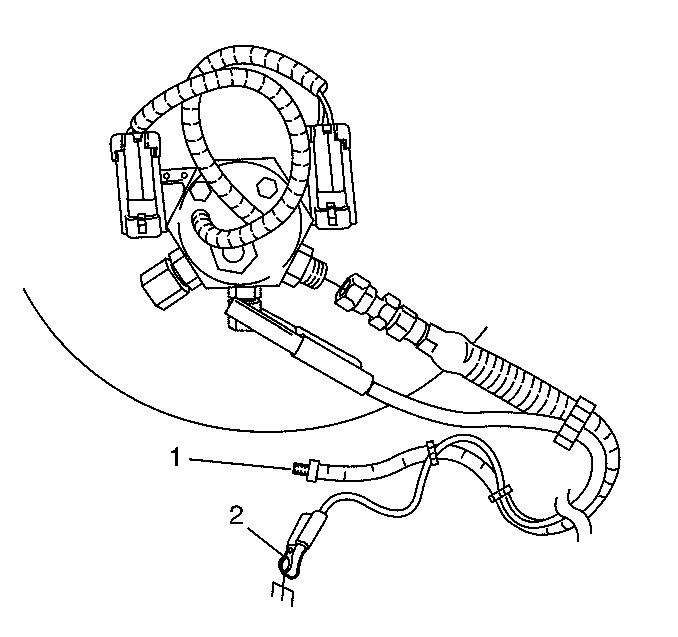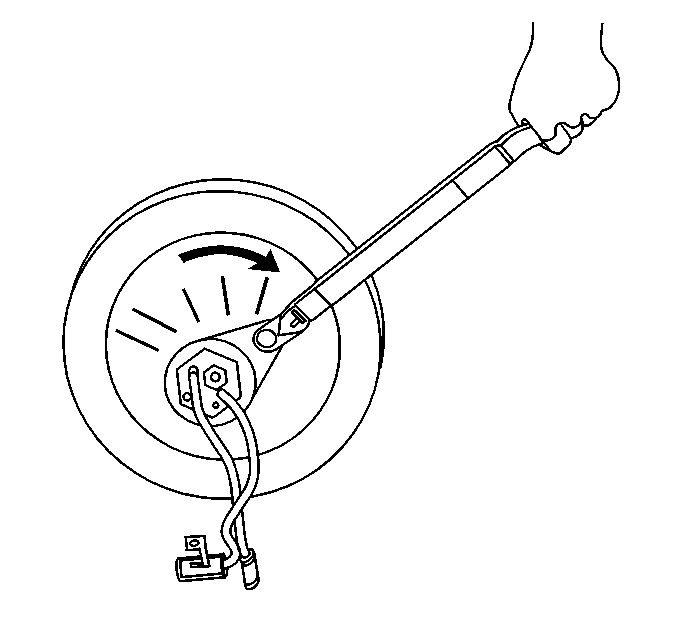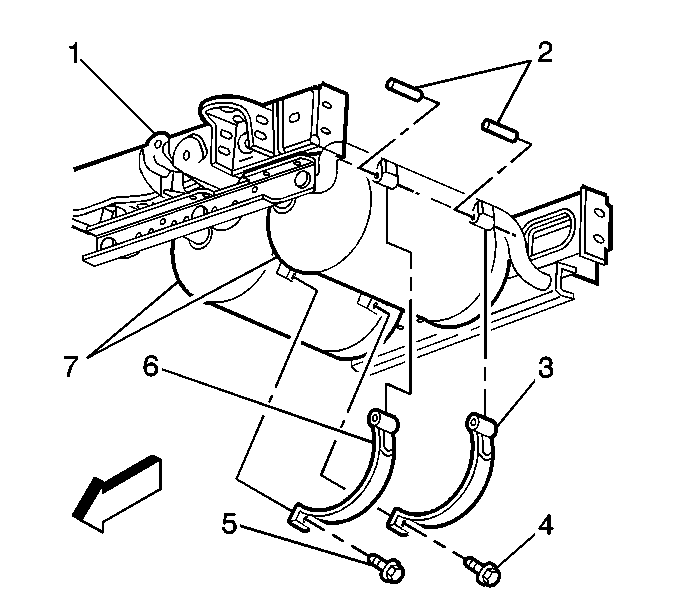Tools Required
Removal Procedure
Caution: Do not install this part if you can not completely refill the vehicle with CNG
after a repair. Failure to properly leak-check the system after the part
replacement may result in serious injury, death, or damage to the vehicle
or the part.
- Remove the fuel tank shield. Refer to
Fuel Tank Shield Replacement
.
- Relieve the CNG fuel system line pressure. Refer to
Fuel Pressure Relief
.
Caution: Always use the J 42435-B Compressed Natural Gas (CNG) Fuel Tank Venting Kit in conjunction with the General Motors approved Fuel Tank Venting service procedure to vent CNG fuel tanks. Failure
to use the J 42435-B and follow the approved Fuel Tank Venting procedure could result in death, serious injury or vehicle and component damage.
The J 42435-B is required for the following reasons:
| • | Natural gas fuel vapor can also contain water vapor. |
| • | The pressure drop associated with venting high pressure gaseous fuel can cause fuel vapor, tank and line temperatures to reach -73°C (-100°F) or colder. |
| • | The below freezing temperature can cause the water vapor to freeze |
| • | The J 42435-B vent hose contains an orifice which is intended to freeze before the CNG high pressure lock-off (HPL) tank valve freezes. |
| • | The J 42435-B pressure gauge can indicate a restricted orifice if fuel flow ceases. |
| • | Internal
fuel tank ice build-up may result when venting the CNG fuel tank without the J 42435-B. |
| - | Internal
fuel tank ice build-up can completely restrict the venting of fuel. |
| - | Venting may cease indefinitely depending upon ambient temperature conditions. |
| - | The ceasing of fuel tank venting may falsely indicate that the fuel tank pressure has been completely vented. |
| - | CNG fuel tanks with exceptionally high water content are suceptible to internal fuel tank ice build-up even with the use of the J 42435-B. |
- Venting natural gas is no longer audible from the vent stack.
- Close the J 42435-B ¼-turn valve and stabilize the fuel tank and line assembly at a temperature greater than 7°C (45°F) for at least 4 hours.
| | If the ambient temperature is less than 7°C (45°F), warm the fuel
tank and vent line assembly manually, either with warm water or by placing the tank and line assembly into a warm environment. |
- The J 42435-B pressure gauge indicates 0 kPa (0 psi).
- Vent the internal CNG fuel pressure from the tank. Refer to
Fuel Tank Venting
.

- Disconnect the vent hose (1) from the HPL.
- Remove the manual vent tool and all fittings.
- Remove the fuel inlet fitting from the HPL and discard the O-rings.
- Remove the fuel outlet fitting from the HPL and discard the O-rings.
Caution: Unless directed otherwise, the ignition and start switch must be in the OFF or LOCK position, and all electrical loads must be OFF before servicing
any electrical component. Disconnect the negative battery cable to prevent an electrical spark should a tool or equipment come in contact with an exposed electrical terminal. Failure to follow these precautions may result in personal injury and/or damage to
the vehicle or its components.
- Disconnect the negative battery cable. Refer to
Battery Negative Cable Disconnection and Connection
in Engine Electrical in the G Van Platform Service Manual.

- Using the
J 43602
HPL crowfoot removal tool, loosen the HPL.
- Remove the CNG fuel tank from the vehicle. Refer to
Fuel Tank Replacement
.
- Unthread the HPL from the CNG fuel tank and discard the O-ring.
- Inspect the inside of the CNG fuel tank for water, rust, or other contaminants.
- If necessary, clean the CNG fuel tank. Refer to
Fuel Tank Cleaning
.
Installation Procedure
- Install a NEW O-ring on the HPL.
- Lubricate the O-ring with petroleum jelly.
- Install the HPL in the tank and tighten hand-tight.
- Install the tank into the vehicle ensuring that the HPL will be properly oriented for reconnection of the fuel lines.
| • | Install the tank using the OLD mounting strap nuts and bolts. |
| • | Do not install the fuel line fittings. |

Notice: Use the correct fastener in the correct location. Replacement fasteners
must be the correct part number for that application. Fasteners requiring
replacement or fasteners requiring the use of thread locking compound or sealant
are identified in the service procedure. Do not use paints, lubricants, or
corrosion inhibitors on fasteners or fastener joint surfaces unless specified.
These coatings affect fastener torque and joint clamping force and may damage
the fastener. Use the correct tightening sequence and specifications when
installing fasteners in order to avoid damage to parts and systems.
- Tighten the HPL as specified below.
Tighten
Tighten the HPL to a nominal torque of 305 N·m (225 lb ft) at 0 degrees. You must compensate for the torque wrench and the HPL crowfoot. Refer to the formula below for compensation of the
torque wrench.
Important: Ensure that the
J 43602
HPL crowfoot removal tool is straight (0 degrees) on the torque wrench.
- To obtain your dial reading perform the following procedure:
| • | Multiply your torque wrench length in inches by 305 (225). |
| • | 18 inch torque wrench example: 18 X 305 = 5,490. |
| • | Add 3 to the length of your torque wrench. |
| • | 18 inch torque wrench example: 18 + 3 = 21. |
| • | Divide the first value obtained by the second value obtained. The result indicates the amount of torque your wrench should tighten the HPL to. |
| • | 18 inch torque wrench example: 5,490 divided by 21 = 261.4. |
| • | For an 18 inch long torque wrench tighten the HPL to 261.4 N·m. |

- Remove the OLD mounting strap nuts and bolts (4, 5) and discard them.
The rear tank is shown. The front tank is similar.
- Ensure that the tank is properly oriented for fuel line connection.
- Install NEW mounting strap bolts and nuts.
Tighten
Tighten the mounting strap nuts to 47 N·m (35 lb ft).
- Complete the fuel tank installation by connecting the fuel lines, electrical connectors and fuel tank pressure sensor. Refer to
Fuel Tank Replacement
.
Caution: The high pressure lock-off solenoid seal is more likely
to leak at a lower fuel pressure. Always perform the fuel leak procedure exactly
as specified. Failure to follow the proper procedures may result in serious
injury or damage to the vehicle or part.
- Fuel the vehicle and check for CNG fuel leaks in 3 stages at the following pressures:
- Using the
J 41416
, inspect for fuel leaks at the HPL at EACH pressure.
Caution: Unless directed otherwise, the ignition and start switch must be in the OFF or LOCK position, and all electrical loads must be OFF before servicing
any electrical component. Disconnect the negative battery cable to prevent an electrical spark should a tool or equipment come in contact with an exposed electrical terminal. Failure to follow these precautions may result in personal injury and/or damage to
the vehicle or its components.
- Connect the negative battery cable. Refer to
Battery Negative Cable Disconnection and Connection
in Engine Electrical in the G Van Service Manual.
- Start and operate the engine on CNG.
- Inspect for fuel leaks at each serviced fitting using the
J 41416
.
- Attach the information label supplied with the replacement HPL in a visible location on the head of the tank.
- Install the tank shield. Refer to
Fuel Tank Shield Replacement
.




